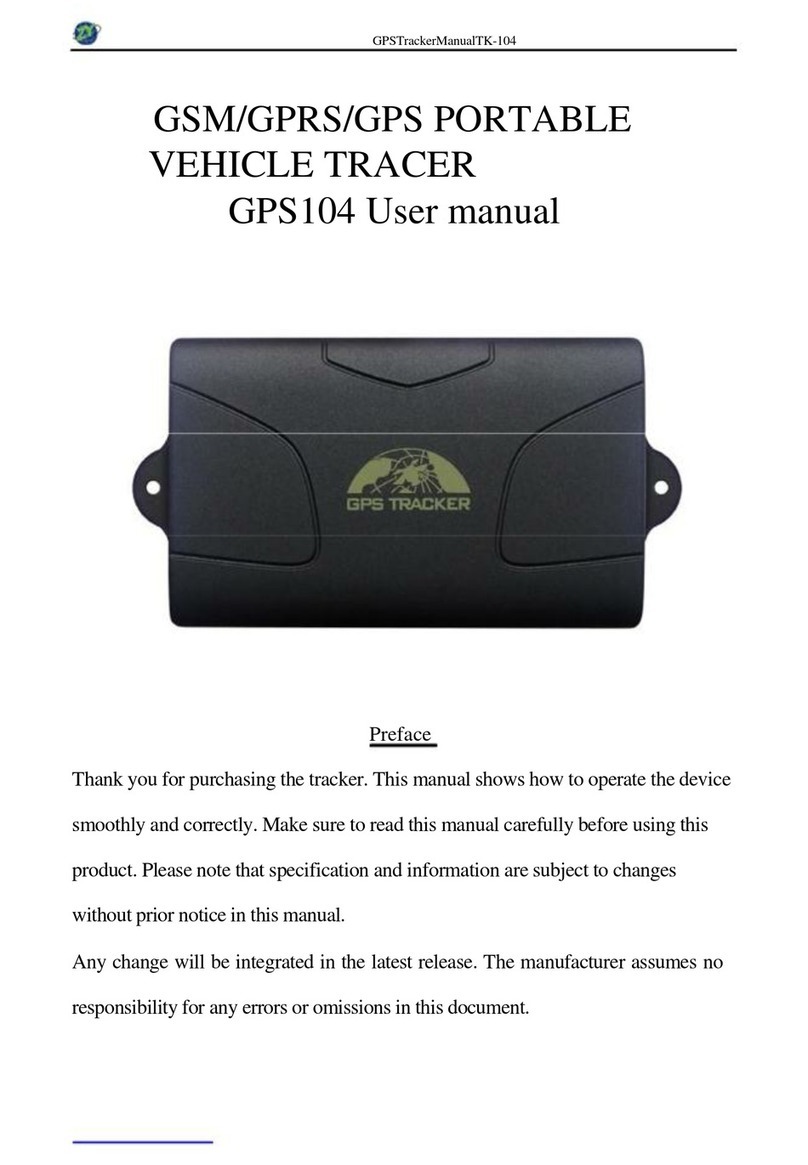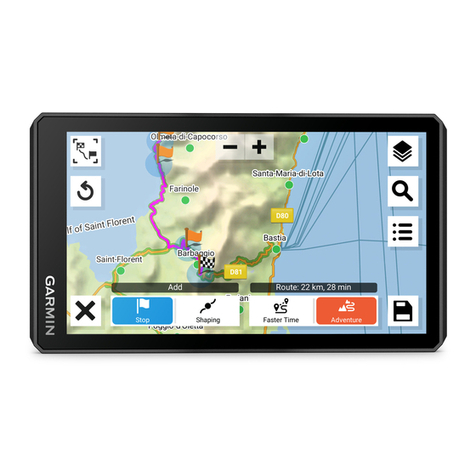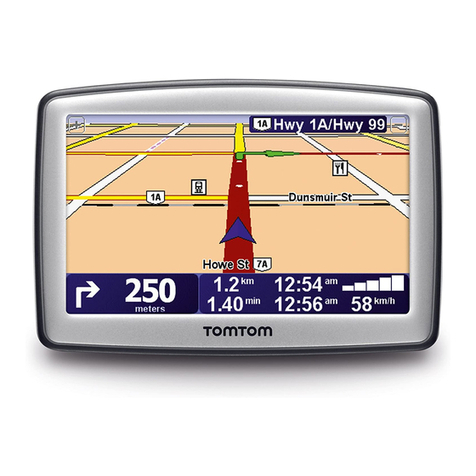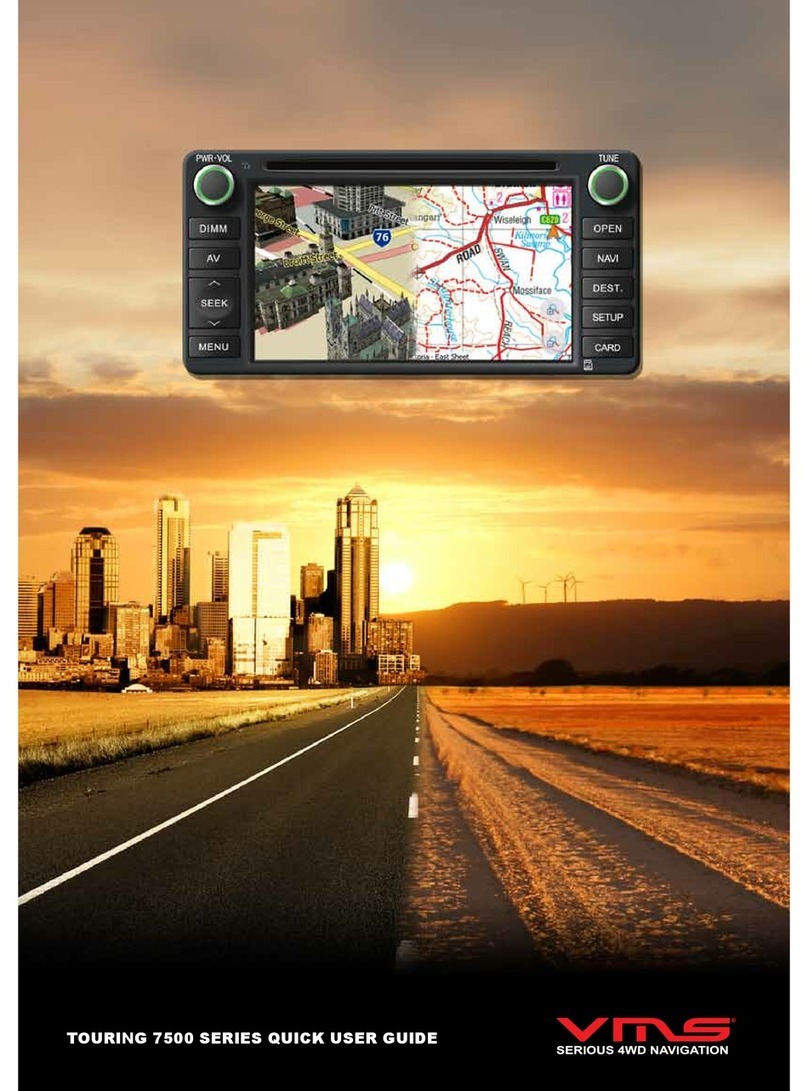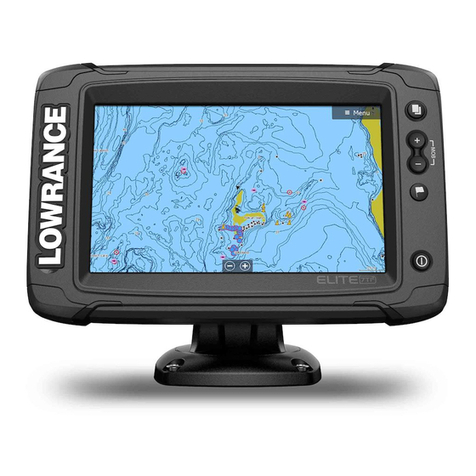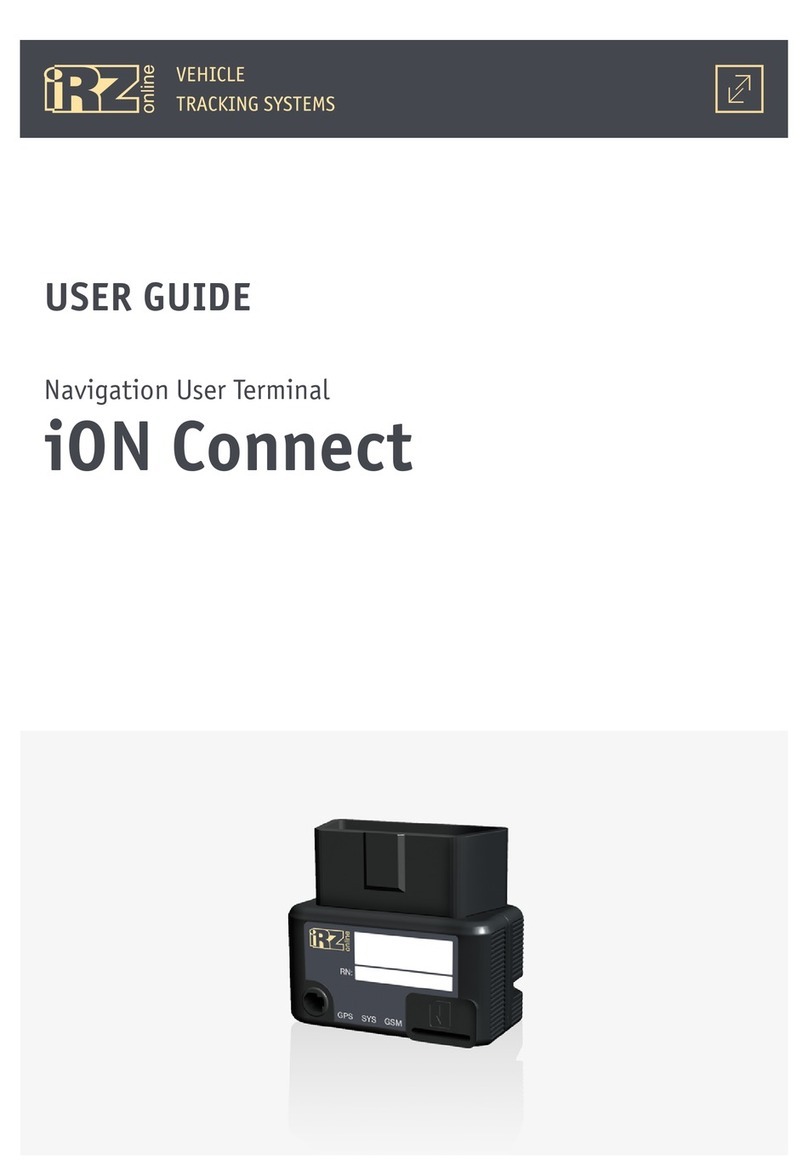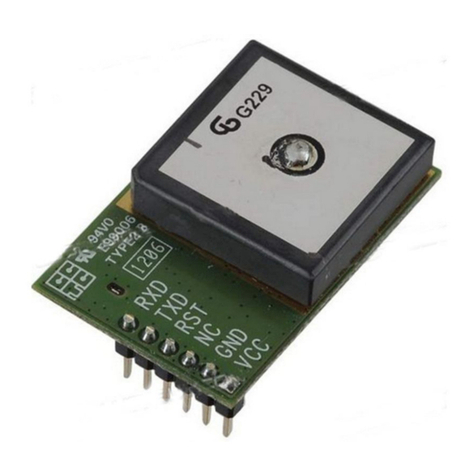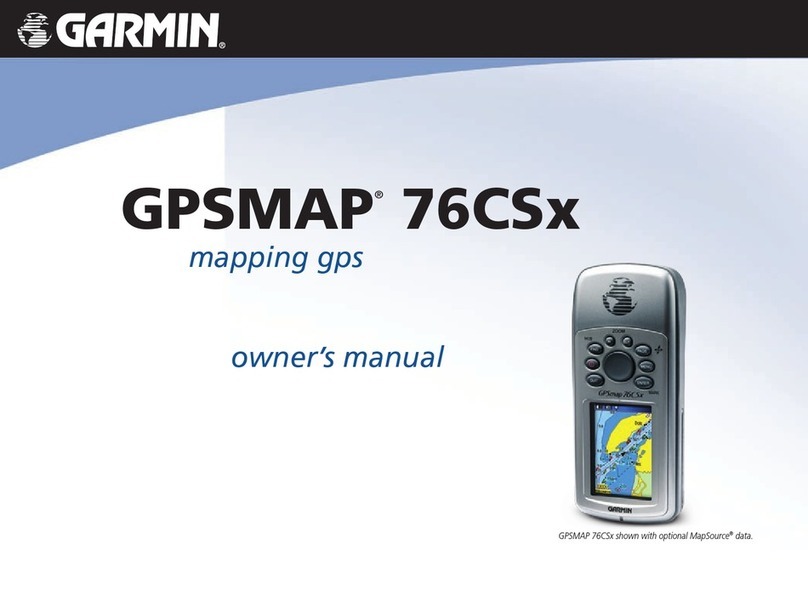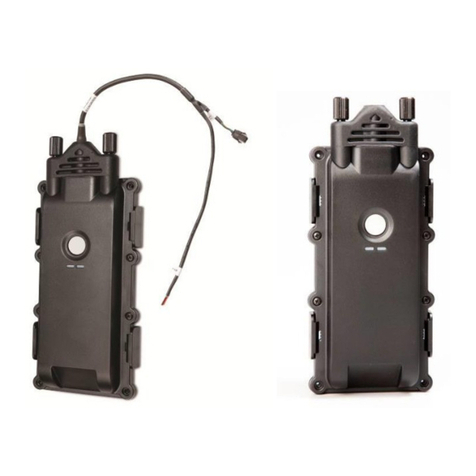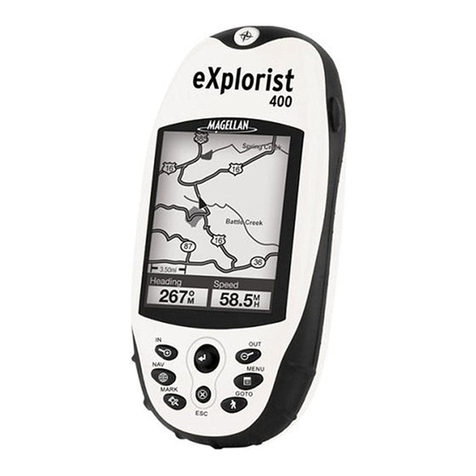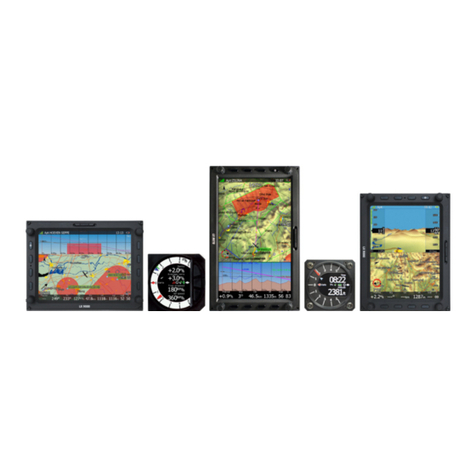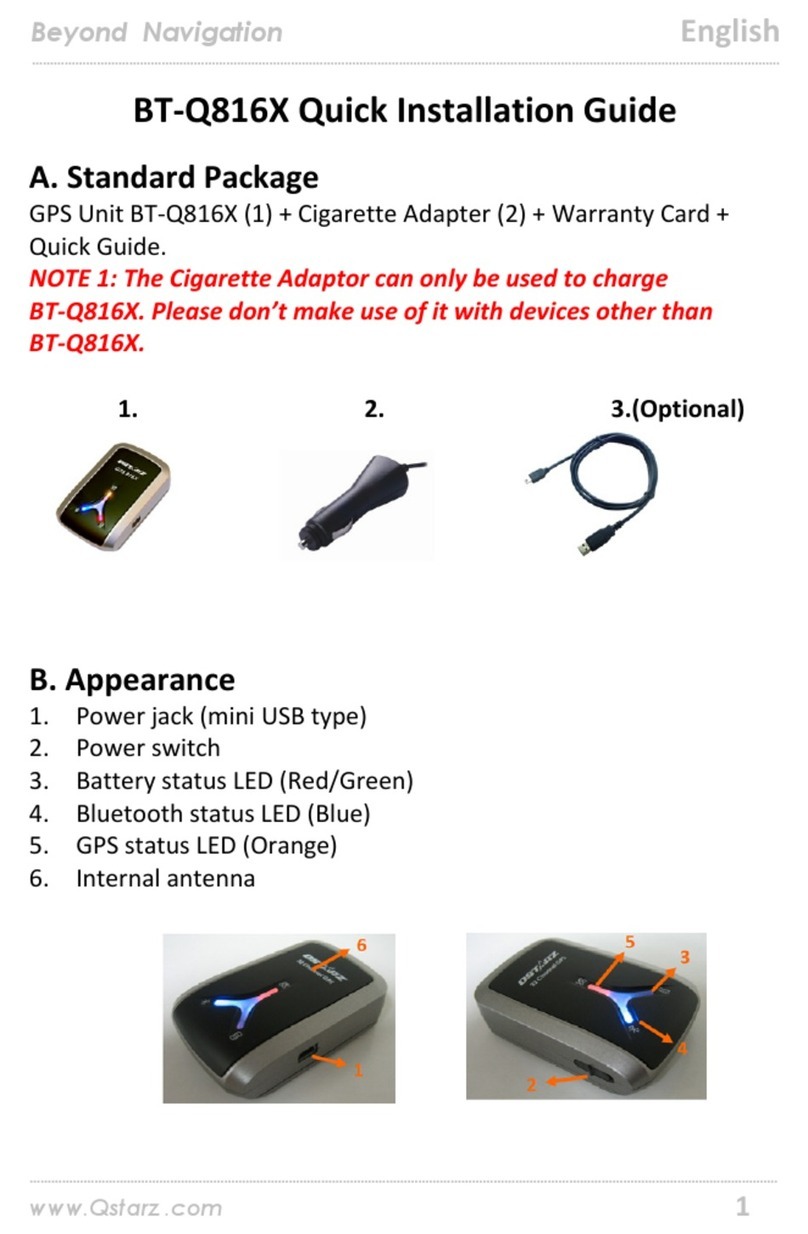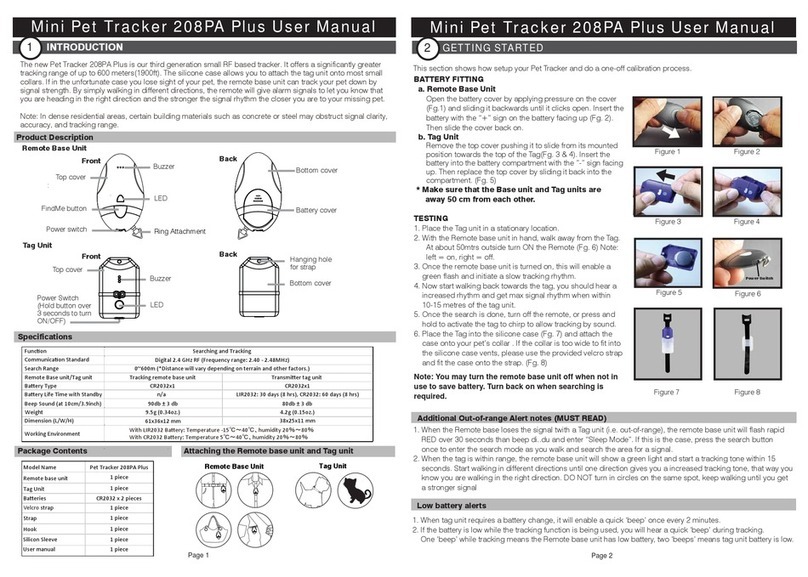FITRE SnowBip RT3 User manual

Insert 2 batteries 1.5 V in the back compartment of the
SnowBip RT3, by respecting the marked polarities. Then
close with care the battery door, by tightening the closing
knob. Use only alkaline batteries of primary brand
(Duracell or similar), “AA” (LR6) size (14 mm diameter, 50
mm length).
POWER SUPPLY
VOLUME STEPS IN SEARCH MODE (1 TO 9)
The SnowBip RT3 has as many as 9 standard sensitivity
steps (represented by the figure of the volume, to ,
which appears on the display), each step corresponding to
a different distance range from the transmitting beacon.
At its switching into the mode, the beacon sets
automatically at volume (max. sensitivity), step that then
decreases automatically, step by step, together with the
progressive increasing level of the received radio-signals,
according to the progressive approaching to the
transmitting beacon. Inside each one of the volume steps,
the intensity of the acoustic “bips” generated by the
SnowBip RT3 increases following the approaching to the
transmitting beacon. Once the highest acoustic intensity
has been reached (”saturation” value, beyond which the
intensity cannot rise any more), the automatic reduction of
one volume step springs up, together with a sharp intensity
drop of the acoustic signal (and of the circular bargraph,
which is visually reproducing the intensity value), to allow
the detection of new increases of the acoustic signal, as a
consequence of further approachings.
19
SEARCH
9
PRIMARY SEARCH PHASE
You must detect the first, even weak, acoustic signals. In the
lack of useful signals, the SnowBip RT3 sets its sensitivity
volume on the step . In order to make the first
detections easier, move slowly your beacon from the left to
the right and from up to down. If there are more rescue
people, all equipped with their SnowBip RT3, then draw up
them fan-wise, spaced out up to 40 m each other, distance
to be halved for the rescuers at the avalanche borders. In
this phase using the supplied earphone can be useful.
automatically 9
SWITCH ON - SELF TEST - SEND MODE
Switch-on the SnowBip RT3 to the position, by rotating
anti-clockwise and thoroughly the knob placed on the back
of the unit. A self-test cycle starts automatically, during
which you can read few seconds, the
charging state of the batteries expressed in (per-cent).
With new batteries, the reading can change from 95 to
99%. At the end of the self-test cycle, with successful
result, the “ ” message appears followed by a short
acoustic signal. Then the beacon sets automatically into
the , which is confirmed by a flashing led and
by a “bip-bip” pacifier tone, repeated every 10 minutes
(exclusive feature of the SnowBip RT3). When, at the self-
test cycle, the charging state of the batteries is detected
lower than 10% (down to 6%), then a repeated display
flashing of the battery icon and the “ ” (Change battery)
message recommend to the user of changing the batteries
. If the user should not do that, he
would then risk of reaching a threshold (5%), under which
the energy reserve required by official standards for
considering the battery check as positive (at least 20 hours
on SEND MODE plus 1 hour on SEARCH MODE), would
no more be guaranteed. The failure of the battery check is
shown on the display through the flashing of the value “ ”
and of the message “ ”, together with the battery icon (of
course the beacon’s working would be however allowed,
until the residual stored energy could make it possible).
If, by chance, the self-test cycle should detect a beacon’s
damage (e.g. the break of an antenna) then the flashing
message “ ” (Error), followed by “ ”, would warn the
user not to trust anymore on his own beacon. The beacon
working would be nevertheless enabled (even if with the
weakening due to the kind of damage) in case this event
should occur just during a tour, but back to home the user
shall have to consider it as no more working and he shall
avoid to use it again on a tour before having it repaired.
ON
%
Ok
SEND MODE
Cb
0%
no
Er no
on the display, by
as soon as possible
Note: the self-test cycle, even carefully made, cannot however be
considered as exhaustive; the user is therefore invited to return
the beacon to factory, in case he should find out some anomalies,
even if the self-test should end with the message “ ”.Ok
FROM SEND MODE TO SEARCH MODE
For switching the SnowBip RT3 into the mode,
please press shortly and consecutively the
key. The SnowBip RT3 gives out a short acoustic signal,
then it displays again the charging state of the batteries
(as %) and finally it sets on listening eventual radio-
signals, at its maximum sensitivity, corresponding to
volume step .
SEARCH
3 times MODE
9
Note: the sensitivity of volume step is very high and it has the purpose
of detecting radio-signals at a great distance from the transmitting
beacon; such a high sensitivity must be however used just on
open field, and not inside or around of buildings, which are always
seat of polluting and unbearable radio noise, which would wrongly
affect the displayed readings on the unit.
9
BEACON DESCRIPTION
LCD DISPLAY wide size, with automatic
back-light (see display readings at page 3)
“MODE” KEY for setting the operation mode
SEARCH mode: press shortly 3 times
SEND mode: press for at least 2 seconds,
up to the acoustical signal
·
·
WARNING LED
to testify the SEND mode operation
EARPHONE waterproof OUTLET
SERIAL NUMBER indelibly engraved
BATTERY DOOR with waterproof protection
DOOR SCREW with D-ring and coin-groove
means for hand operation
LOUDSPEAKER with automatic
compensation of the atmospheric pressure
ELASTIC HAND STRAP with clip hook
fastening to the body harness system
LIGHT SENSOR for driving
the display back-light (in SEARCH mode)
ROTARY SWITCH
to turn ON and OFF the unit
NAME LABEL sticking area
COMPARTMENT for 2 alkaline BATTERIES
1.5V (“AA” or “LR6” size)
VOLUME STEP-DOWN KEY
to reduce the distance range
(min step = 1: see the display window)
VOLUME STEP-UP KEY
to increase the distance range
(max step = 9: see the display window)
Outside detail of the battery door,
with RESCUE PROCEDURE memo label
14
USER MANUAL
ARVA 457 kHzARVA 457 kHz
ELECTRONIC AVALANCHE BEACONELECTRONIC AVALANCHE BEACON
ARVA 457 kHzARVA 457 kHz
ELECTRONIC AVALANCHE BEACONELECTRONIC AVALANCHE BEACON
USER MANUALUSER MANUAL
CODE 7431300
SNOWBIP RT3SNOWBIP RT3
ANALOG+DIGITAL 2-ANTENNA AVALANCHE BEACONANALOG+DIGITAL 2-ANTENNA AVALANCHE BEACON
FITRE S.p.A.
Electronics & Telecommunications
20142 Milano – Italy
via Valsolda, 15
phone: +39.02.8959.01
fax: +39.02.8959.0400
web site: www.fitre.it
Branch offices in Rome and Venice
Company Quality System
UNI EN ISO 9001:2000 certified
AC 8114 – ed. 0404 – ENG • ARVA SnowBip RT3 ( User Manual
© Fitre S.p.A. – All rights reserved • The information contained in this publication are not binding and are subject to change without notice
code 7431300)
IMPORTANT WARNING
Just the fact of carrying with you the powerful SnowBip
RT3 can’t protect you against the avalanche risk!
The maximum care is always recommended when
facing avalanche hazard areas.
Always carry with you a probe and a shovel, in
addition to your ARVA, to shorten the rescue operation.
LIMITED WARRANTY
Your SnowBip RT3 is warranted for 3 years
from the purchase date against damages to
the product due to manufacturing defects.
This warranty does not then cover damages
to the product due to uncareful use or to
normal wear and tear.
Batteries and accessories (including
earphone and carrying items) are excluded
from this warranty.
GIFT-BOX CONTENTS
·
·
·
·
·
·
ARVA beacon SnowBip RT3
body harness system
twin-set earphone
2 alkaline batteries 1.5V AA size
storing cloth-bag
this user manual
TECHNICAL DATA
·
·
·
battery life: 450 hours in SEND mode,
plus 10 hours in SEARCH mode
operating temperature: -30 to +55 °C
storing temperature: -40 to +70 °C
Wear the harness system with the light grey
straps over your shoulders and adjust the
length of the upper and lower straps; the
beacon hand strap must be fastened by its
clip hook to a shoulder strap buckle, so
avoiding the risk of losing the beacon itself
when using it out from its sheath for
searching operations.
HARNESS WEARING UP

After having located the last one buried beacon, then
please switch back again to the mode your beacon,
in the event of a second avalanche. The same action must
be immediately carried out, while being in the
process, whenever you realize that a new avalanche is
coming. The action consists in pressing, for at least 2
seconds, till an acoustic signal, the key. In order to
make up to possible lacks of that, a proper watch circuit of
the SnowBip RT3 takes care of switching automatically
the beacon into the mode, in case no key pressing
should be detected for a time of 4 minutes. A special
acoustic signal forewarns the user about such impending
event, giving then him the possibility to break off, for
further 4 minutes, the pending operation, through the
short pressing of any key.
SEND
SEARCH
MODE
SEND
FROM SEARCH MODE TO SEND MODE
FINAL SEARCH PHASE
When approaching below 10 metres the transmitting
buried beacon, then your SnowBip RT3 starts giving out
some additional acoustic “bips”, more and more frequent
as approaching goes on. In the last phases of the search,
keep your beacon close to the snow, in order to reduce the
distance from the buried beacon and to enhance the
accuracy of the detection. Watch the reading of the
distance and evaluate the frequency of the acoustic “bips”.
The displayed volume step digit must decrease further on
(towards the volume , which however can be reached
only at condition that the transmitting beacon is not buried
at excessive depth), so to get the reduction, step by step,
of the distance range within which the acoustic “bips” are
detected. When, by a cross shifting of the beacon, both in
any direction and its opposite, you get a worsening of the
acoustic signals (as well as of the distance reading and of
the circular bargraph shown on the display), then you are
located exactly on the vertical of the transmitting beacon.
1
Note: intentionally just the reduction of the volume steps has been
automated, to reduce step by step the distance range within which
it is possible getting the acoustic "bips"; going out of this range,
mainly on the lower volume steps, the "bips" decay very quickly
and it is so very intuitive of going back to where they were stronger
and starting again searching further acoustic increments.
SEARCH OF FURTHER BURIED BEACONS
Note: by repeating the same action which excluded the automation
(short pressing, at the same time, of the and keys), the
automation itself can be turned on again, if it is useful or preferred;
the detection of more buried people (more transmitting beacons)
is warned out by the SnowBip RT3 with a special displayed icon.
Once having located the first transmitting beacon, it's
necessary to shovel fast the snow away from the buried
person and then to switch off his beacon quickly, to the aim
of avoiding that its no more useful radio-signals could
trouble the search of the other buried beacons. Before that
could be done, press shortly, at a same time, the and
keys of the SnowBip RT3 you’re using in mode,
in order to get the barring of the automation which has
quickened the finding of the first buried beacon, but which
now could trouble the detection of the further ones, being
the found one still the closest one. From now on, the
sensitivity volume can be changed just manually, through
the or key, and this operating mode is warned by the
displayed icons . In the
presence of more transmitting beacons, your beacon
reproduces now accurately, by its loudspeaker, with
different intensity according to the distance, the only radio-
signals coming from each transmitting beacon located
within the range allowed by the set volume step. Likewise
your display will show bargraph, direction arrow and
distance reading concerning each transmitting beacon. By
acting properly on the or keys, you can now extend
(by stepping up to volume ) or reduce (by stepping down
to volume ) the range of your SnowBip RT3, so to single
out the acoustic “bips” coming out from the radio-signals of
a second buried beacon, towards which then to move,
even following the displayed information. And so on for the
further beacons. While approaching to a new transmitting
beacon, choose the lowest possible (still audible) volume
step and therefore the lowest possible distance range (at
volume this is just a little more than 1 meter). So you can
select, and look at, a single transmitting beacon at a time
(time by time, the nearest one), by isolating it from all the
others. In the same way more rescuers can split up the
task of searching more buried beacons, by proceeding in
parallel, at the same time, towards more targets.
SEARCH
MANUAL barred circle
9
1
1
and
SECONDARY SEARCH PHASE
After having detected the first acoustic “bips”, then move
yourself in the direction their intensity increases. If your
SnowBip RT3 is set on the volume +, (for having
pressed the key when being on ), then as soon as the
acoustic “bips” have reached a good intensity, go back to
(look at the display) by long pressing the key.
Going on to approaching the buried beacon, from now on,
watch the display for checking:
the progressive reduction of the distance, once this
reading appeared;
the constant reduction of the volume step (from to );
the progressive increasing of the circular bargraph,
within a same volume step;
the arrow indication suggesting the direction to keep in
order to approach the transmitting beacon (go on by
pointing your beacon so as to get the central arrow
switched on, with the warning that, if the reading of the
distance increases, then you must turn your beacon of
180 degrees and proceed in the opposite direction).
9
9
9
91
v
v
v
v
EXTRA VOLUME STEP IN SEARCH MODE (9+)
In addition to the 9 standard volume steps ( to ), the
SnowBip RT3 has an additional sensitivity step, called +,
just manually controlled, enabling a further extension of
the search range when, even at volume , no signal
coming from transmitting beacons is detected. When your
SnowBip RT3 is set on volume , you can switch to volume
+ by pressing the key and by checking the displaying
of the icon alone. The opposite switching, from
+ to , can be instead got by pressing the key up to the
appearing of the digit on the display.
19
9
9
9
9
MANUAL
99
9
EXAMPLES OF DISPLAY MESSAGES
·
·
self-test cycle
negatively
concluded
fault beacon or
batteries no more
reliable
·
·
negative self-test
cycle
”error” code 3
·
·
·
·
arrow at center-
right
bargraph at 70%
distance 1.40
meters
volume step 3
·
·
”change batteries”
change the
batteries as soon
as possible
·
·
·
·
arrow at the left
bargraph at 20%
distance 22 meters
volume step 8
·
·
charging state of
the batteries: 10%
still efficient
batteries, but to be
changed as soon
as possible
·
·
·
·
arrow at the center
bargraph at 40%
distance 56 meters
volume step 9
·self-test cycle
positively
concluded
·reading of the
charging state of
the batteries
·
·
·
·
automation barred
radio-signal too
“low” (Lo) for the
set volume-step
volume step 2 and
invitation to press
the key to
increase it
more transmitting
beacons detected
(”multi-buried” icon)
·
·
·
volume step 9+
(max-plus
sensitivity)
just manual
operation
switch then back to
volume 9, by
pressing the key
·
·
·
·
·
automation barred
bargraph at 100%
(saturation)
arrow and distance
not available
radio-signal too
“high” (HI) for the
set volume-step
volume step 8 and
invitation to press
the key to
decrease it
DURING SEND MODE (TRANSMIT)
·
·
continuos LED flashing
acoustic ”bip-bip” pacifier tone every
10 minutes (exclusive of SnowBip RT3)
FROM SEND TO SEARCH MODE
·press shortly and consecutively,
3 times, the keyMODE
FROM SEARCH TO SEND MODE
·press for at least 2 seconds
the key, up to an acoustical signalMODE
DURING SEARCH MODE (RECEIVE)
·
·
·
·
·
special acoustic warning every 4 minutes
press shortly any key, once,
to get further 4 minutes of search mode
otherwise, with further acoustic warning,
SnowBip RT3 switches to SEND MODE
when just located the first buried beacon
(having not yet switched it off), press
shortly together the and keys for
barring automation
same operation for turning on
automation again
AUTOMATION BARRING (”multi-buried”)
READINGS:
DISTANCE DIGITS
(0,1 m to 99 m)
% BATTERY
(6% to 99%)
MESSAGES
·
·
·
BARRED CIRCLE
BARGRAPH OF
10 CIRCLES
(measures the intensi-
ty of radio-signals)
SAND-GLASS ICON:
DON’T MOVE
WHEN LIT
5 ARROWS
(DIRECTION)
INVITATION TO
PRESS THE KEY
to reduce the volume
INVITATION TO
PRESS THE KEY
to increase the volume
MULTI-BURIED
ICON
“MANUAL” ICON:
if alone: volume step
is 9+ (max-plus
distance range, just
manual operation)
if with BARRED
CIRCLE: automation
is barred
·
·
VOLUME STEP
(1 to 9): distance
range MIN to MAX
BATTERY ICON
(% of charging state):
if flashing with
change batteries
as soon as possible
·
·
Ô
if flashing with
batteries no
more reliable
Ô
32 USER MANUALUSER MANUAL
ARVA 457 kHzARVA 457 kHz
ELECTRONIC AVALANCHE BEACONELECTRONIC AVALANCHE BEACON
ARVA 457 kHzARVA 457 kHz
ELECTRONIC AVALANCHE BEACONELECTRONIC AVALANCHE BEACON
WHEN AUTOMATION BARRED:
·
·
no additional acoustic “bips” near transmitting beacons
no automatic volume steps decrease in approaching

After having located the last one buried beacon, then
please switch back again to the mode your beacon,
in the event of a second avalanche. The same action must
be immediately carried out, while being in the
process, whenever you realize that a new avalanche is
coming. The action consists in pressing, for at least 2
seconds, till an acoustic signal, the key. In order to
make up to possible lacks of that, a proper watch circuit of
the SnowBip RT3 takes care of switching automatically
the beacon into the mode, in case no key pressing
should be detected for a time of 4 minutes. A special
acoustic signal forewarns the user about such impending
event, giving then him the possibility to break off, for
further 4 minutes, the pending operation, through the
short pressing of any key.
SEND
SEARCH
MODE
SEND
FROM SEARCH MODE TO SEND MODE
FINAL SEARCH PHASE
When approaching below 10 metres the transmitting
buried beacon, then your SnowBip RT3 starts giving out
some additional acoustic “bips”, more and more frequent
as approaching goes on. In the last phases of the search,
keep your beacon close to the snow, in order to reduce the
distance from the buried beacon and to enhance the
accuracy of the detection. Watch the reading of the
distance and evaluate the frequency of the acoustic “bips”.
The displayed volume step digit must decrease further on
(towards the volume , which however can be reached
only at condition that the transmitting beacon is not buried
at excessive depth), so to get the reduction, step by step,
of the distance range within which the acoustic “bips” are
detected. When, by a cross shifting of the beacon, both in
any direction and its opposite, you get a worsening of the
acoustic signals (as well as of the distance reading and of
the circular bargraph shown on the display), then you are
located exactly on the vertical of the transmitting beacon.
1
Note: intentionally just the reduction of the volume steps has been
automated, to reduce step by step the distance range within which
it is possible getting the acoustic "bips"; going out of this range,
mainly on the lower volume steps, the "bips" decay very quickly
and it is so very intuitive of going back to where they were stronger
and starting again searching further acoustic increments.
SEARCH OF FURTHER BURIED BEACONS
Note: by repeating the same action which excluded the automation
(short pressing, at the same time, of the and keys), the
automation itself can be turned on again, if it is useful or preferred;
the detection of more buried people (more transmitting beacons)
is warned out by the SnowBip RT3 with a special displayed icon.
Once having located the first transmitting beacon, it's
necessary to shovel fast the snow away from the buried
person and then to switch off his beacon quickly, to the aim
of avoiding that its no more useful radio-signals could
trouble the search of the other buried beacons. Before that
could be done, press shortly, at a same time, the and
keys of the SnowBip RT3 you’re using in mode,
in order to get the barring of the automation which has
quickened the finding of the first buried beacon, but which
now could trouble the detection of the further ones, being
the found one still the closest one. From now on, the
sensitivity volume can be changed just manually, through
the or key, and this operating mode is warned by the
displayed icons . In the
presence of more transmitting beacons, your beacon
reproduces now accurately, by its loudspeaker, with
different intensity according to the distance, the only radio-
signals coming from each transmitting beacon located
within the range allowed by the set volume step. Likewise
your display will show bargraph, direction arrow and
distance reading concerning each transmitting beacon. By
acting properly on the or keys, you can now extend
(by stepping up to volume ) or reduce (by stepping down
to volume ) the range of your SnowBip RT3, so to single
out the acoustic “bips” coming out from the radio-signals of
a second buried beacon, towards which then to move,
even following the displayed information. And so on for the
further beacons. While approaching to a new transmitting
beacon, choose the lowest possible (still audible) volume
step and therefore the lowest possible distance range (at
volume this is just a little more than 1 meter). So you can
select, and look at, a single transmitting beacon at a time
(time by time, the nearest one), by isolating it from all the
others. In the same way more rescuers can split up the
task of searching more buried beacons, by proceeding in
parallel, at the same time, towards more targets.
SEARCH
MANUAL barred circle
9
1
1
and
SECONDARY SEARCH PHASE
After having detected the first acoustic “bips”, then move
yourself in the direction their intensity increases. If your
SnowBip RT3 is set on the volume +, (for having
pressed the key when being on ), then as soon as the
acoustic “bips” have reached a good intensity, go back to
(look at the display) by long pressing the key.
Going on to approaching the buried beacon, from now on,
watch the display for checking:
the progressive reduction of the distance, once this
reading appeared;
the constant reduction of the volume step (from to );
the progressive increasing of the circular bargraph,
within a same volume step;
the arrow indication suggesting the direction to keep in
order to approach the transmitting beacon (go on by
pointing your beacon so as to get the central arrow
switched on, with the warning that, if the reading of the
distance increases, then you must turn your beacon of
180 degrees and proceed in the opposite direction).
9
9
9
91
v
v
v
v
EXTRA VOLUME STEP IN SEARCH MODE (9+)
In addition to the 9 standard volume steps ( to ), the
SnowBip RT3 has an additional sensitivity step, called +,
just manually controlled, enabling a further extension of
the search range when, even at volume , no signal
coming from transmitting beacons is detected. When your
SnowBip RT3 is set on volume , you can switch to volume
+ by pressing the key and by checking the displaying
of the icon alone. The opposite switching, from
+ to , can be instead got by pressing the key up to the
appearing of the digit on the display.
19
9
9
9
9
MANUAL
99
9
EXAMPLES OF DISPLAY MESSAGES
·
·
self-test cycle
negatively
concluded
fault beacon or
batteries no more
reliable
·
·
negative self-test
cycle
”error” code 3
·
·
·
·
arrow at center-
right
bargraph at 70%
distance 1.40
meters
volume step 3
·
·
”change batteries”
change the
batteries as soon
as possible
·
·
·
·
arrow at the left
bargraph at 20%
distance 22 meters
volume step 8
·
·
charging state of
the batteries: 10%
still efficient
batteries, but to be
changed as soon
as possible
·
·
·
·
arrow at the center
bargraph at 40%
distance 56 meters
volume step 9
·self-test cycle
positively
concluded
·reading of the
charging state of
the batteries
·
·
·
·
automation barred
radio-signal too
“low” (Lo) for the
set volume-step
volume step 2 and
invitation to press
the key to
increase it
more transmitting
beacons detected
(”multi-buried” icon)
·
·
·
volume step 9+
(max-plus
sensitivity)
just manual
operation
switch then back to
volume 9, by
pressing the key
·
·
·
·
·
automation barred
bargraph at 100%
(saturation)
arrow and distance
not available
radio-signal too
“high” (HI) for the
set volume-step
volume step 8 and
invitation to press
the key to
decrease it
DURING SEND MODE (TRANSMIT)
·
·
continuos LED flashing
acoustic ”bip-bip” pacifier tone every
10 minutes (exclusive of SnowBip RT3)
FROM SEND TO SEARCH MODE
·press shortly and consecutively,
3 times, the keyMODE
FROM SEARCH TO SEND MODE
·press for at least 2 seconds
the key, up to an acoustical signalMODE
DURING SEARCH MODE (RECEIVE)
·
·
·
·
·
special acoustic warning every 4 minutes
press shortly any key, once,
to get further 4 minutes of search mode
otherwise, with further acoustic warning,
SnowBip RT3 switches to SEND MODE
when just located the first buried beacon
(having not yet switched it off), press
shortly together the and keys for
barring automation
same operation for turning on
automation again
AUTOMATION BARRING (”multi-buried”)
READINGS:
DISTANCE DIGITS
(0,1 m to 99 m)
% BATTERY
(6% to 99%)
MESSAGES
·
·
·
BARRED CIRCLE
BARGRAPH OF
10 CIRCLES
(measures the intensi-
ty of radio-signals)
SAND-GLASS ICON:
DON’T MOVE
WHEN LIT
5 ARROWS
(DIRECTION)
INVITATION TO
PRESS THE KEY
to reduce the volume
INVITATION TO
PRESS THE KEY
to increase the volume
MULTI-BURIED
ICON
“MANUAL” ICON:
if alone: volume step
is 9+ (max-plus
distance range, just
manual operation)
if with BARRED
CIRCLE: automation
is barred
·
·
VOLUME STEP
(1 to 9): distance
range MIN to MAX
BATTERY ICON
(% of charging state):
if flashing with
change batteries
as soon as possible
·
·
Ô
if flashing with
batteries no
more reliable
Ô
32 USER MANUALUSER MANUAL
ARVA 457 kHzARVA 457 kHz
ELECTRONIC AVALANCHE BEACONELECTRONIC AVALANCHE BEACON
ARVA 457 kHzARVA 457 kHz
ELECTRONIC AVALANCHE BEACONELECTRONIC AVALANCHE BEACON
WHEN AUTOMATION BARRED:
·
·
no additional acoustic “bips” near transmitting beacons
no automatic volume steps decrease in approaching

Insert 2 batteries 1.5 V in the back compartment of the
SnowBip RT3, by respecting the marked polarities. Then
close with care the battery door, by tightening the closing
knob. Use only alkaline batteries of primary brand
(Duracell or similar), “AA” (LR6) size (14 mm diameter, 50
mm length).
POWER SUPPLY
VOLUME STEPS IN SEARCH MODE (1 TO 9)
The SnowBip RT3 has as many as 9 standard sensitivity
steps (represented by the figure of the volume, to ,
which appears on the display), each step corresponding to
a different distance range from the transmitting beacon.
At its switching into the mode, the beacon sets
automatically at volume (max. sensitivity), step that then
decreases automatically, step by step, together with the
progressive increasing level of the received radio-signals,
according to the progressive approaching to the
transmitting beacon. Inside each one of the volume steps,
the intensity of the acoustic “bips” generated by the
SnowBip RT3 increases following the approaching to the
transmitting beacon. Once the highest acoustic intensity
has been reached (”saturation” value, beyond which the
intensity cannot rise any more), the automatic reduction of
one volume step springs up, together with a sharp intensity
drop of the acoustic signal (and of the circular bargraph,
which is visually reproducing the intensity value), to allow
the detection of new increases of the acoustic signal, as a
consequence of further approachings.
19
SEARCH
9
PRIMARY SEARCH PHASE
You must detect the first, even weak, acoustic signals. In the
lack of useful signals, the SnowBip RT3 sets its sensitivity
volume on the step . In order to make the first
detections easier, move slowly your beacon from the left to
the right and from up to down. If there are more rescue
people, all equipped with their SnowBip RT3, then draw up
them fan-wise, spaced out up to 40 m each other, distance
to be halved for the rescuers at the avalanche borders. In
this phase using the supplied earphone can be useful.
automatically 9
SWITCH ON - SELF TEST - SEND MODE
Switch-on the SnowBip RT3 to the position, by rotating
anti-clockwise and thoroughly the knob placed on the back
of the unit. A self-test cycle starts automatically, during
which you can read few seconds, the
charging state of the batteries expressed in (per-cent).
With new batteries, the reading can change from 95 to
99%. At the end of the self-test cycle, with successful
result, the “ ” message appears followed by a short
acoustic signal. Then the beacon sets automatically into
the , which is confirmed by a flashing led and
by a “bip-bip” pacifier tone, repeated every 10 minutes
(exclusive feature of the SnowBip RT3). When, at the self-
test cycle, the charging state of the batteries is detected
lower than 10% (down to 6%), then a repeated display
flashing of the battery icon and the “ ” (Change battery)
message recommend to the user of changing the batteries
. If the user should not do that, he
would then risk of reaching a threshold (5%), under which
the energy reserve required by official standards for
considering the battery check as positive (at least 20 hours
on SEND MODE plus 1 hour on SEARCH MODE), would
no more be guaranteed. The failure of the battery check is
shown on the display through the flashing of the value “ ”
and of the message “ ”, together with the battery icon (of
course the beacon’s working would be however allowed,
until the residual stored energy could make it possible).
If, by chance, the self-test cycle should detect a beacon’s
damage (e.g. the break of an antenna) then the flashing
message “ ” (Error), followed by “ ”, would warn the
user not to trust anymore on his own beacon. The beacon
working would be nevertheless enabled (even if with the
weakening due to the kind of damage) in case this event
should occur just during a tour, but back to home the user
shall have to consider it as no more working and he shall
avoid to use it again on a tour before having it repaired.
ON
%
Ok
SEND MODE
Cb
0%
no
Er no
on the display, by
as soon as possible
Note: the self-test cycle, even carefully made, cannot however be
considered as exhaustive; the user is therefore invited to return
the beacon to factory, in case he should find out some anomalies,
even if the self-test should end with the message “ ”.Ok
FROM SEND MODE TO SEARCH MODE
For switching the SnowBip RT3 into the mode,
please press shortly and consecutively the
key. The SnowBip RT3 gives out a short acoustic signal,
then it displays again the charging state of the batteries
(as %) and finally it sets on listening eventual radio-
signals, at its maximum sensitivity, corresponding to
volume step .
SEARCH
3 times MODE
9
Note: the sensitivity of volume step is very high and it has the purpose
of detecting radio-signals at a great distance from the transmitting
beacon; such a high sensitivity must be however used just on
open field, and not inside or around of buildings, which are always
seat of polluting and unbearable radio noise, which would wrongly
affect the displayed readings on the unit.
9
BEACON DESCRIPTION
LCD DISPLAY wide size, with automatic
back-light (see display readings at page 3)
“MODE” KEY for setting the operation mode
SEARCH mode: press shortly 3 times
SEND mode: press for at least 2 seconds,
up to the acoustical signal
·
·
WARNING LED
to testify the SEND mode operation
EARPHONE waterproof OUTLET
SERIAL NUMBER indelibly engraved
BATTERY DOOR with waterproof protection
DOOR SCREW with D-ring and coin-groove
means for hand operation
LOUDSPEAKER with automatic
compensation of the atmospheric pressure
ELASTIC HAND STRAP with clip hook
fastening to the body harness system
LIGHT SENSOR for driving
the display back-light (in SEARCH mode)
ROTARY SWITCH
to turn ON and OFF the unit
NAME LABEL sticking area
COMPARTMENT for 2 alkaline BATTERIES
1.5V (“AA” or “LR6” size)
VOLUME STEP-DOWN KEY
to reduce the distance range
(min step = 1: see the display window)
VOLUME STEP-UP KEY
to increase the distance range
(max step = 9: see the display window)
Outside detail of the battery door,
with RESCUE PROCEDURE memo label
14
USER MANUAL
ARVA 457 kHzARVA 457 kHz
ELECTRONIC AVALANCHE BEACONELECTRONIC AVALANCHE BEACON
ARVA 457 kHzARVA 457 kHz
ELECTRONIC AVALANCHE BEACONELECTRONIC AVALANCHE BEACON
USER MANUALUSER MANUAL
CODE 7431300
SNOWBIP RT3SNOWBIP RT3
ANALOG+DIGITAL 2-ANTENNA AVALANCHE BEACONANALOG+DIGITAL 2-ANTENNA AVALANCHE BEACON
FITRE S.p.A.
Electronics & Telecommunications
20142 Milano – Italy
via Valsolda, 15
phone: +39.02.8959.01
fax: +39.02.8959.0400
email: [email protected]
web site: www.fitre.it
Branch offices in Rome and Venice
Company Quality System
UNI EN ISO 9001:2000 certified
AC 8114 – ed. 0404 – ENG • ARVA SnowBip RT3 ( User Manual
© Fitre S.p.A. – All rights reserved • The information contained in this publication are not binding and are subject to change without notice
code 7431300)
IMPORTANT WARNING
Just the fact of carrying with you the powerful SnowBip
RT3 can’t protect you against the avalanche risk!
The maximum care is always recommended when
facing avalanche hazard areas.
Always carry with you a probe and a shovel, in
addition to your ARVA, to shorten the rescue operation.
LIMITED WARRANTY
Your SnowBip RT3 is warranted for 3 years
from the purchase date against damages to
the product due to manufacturing defects.
This warranty does not then cover damages
to the product due to uncareful use or to
normal wear and tear.
Batteries and accessories (including
earphone and carrying items) are excluded
from this warranty.
GIFT-BOX CONTENTS
·
·
·
·
·
·
ARVA beacon SnowBip RT3
body harness system
twin-set earphone
2 alkaline batteries 1.5V AA size
storing cloth-bag
this user manual
TECHNICAL DATA
·
·
·
battery life: 450 hours in SEND mode,
plus 10 hours in SEARCH mode
operating temperature: -30 to +55 °C
storing temperature: -40 to +70 °C
Wear the harness system with the light grey
straps over your shoulders and adjust the
length of the upper and lower straps; the
beacon hand strap must be fastened by its
clip hook to a shoulder strap buckle, so
avoiding the risk of losing the beacon itself
when using it out from its sheath for
searching operations.
HARNESS WEARING UP
